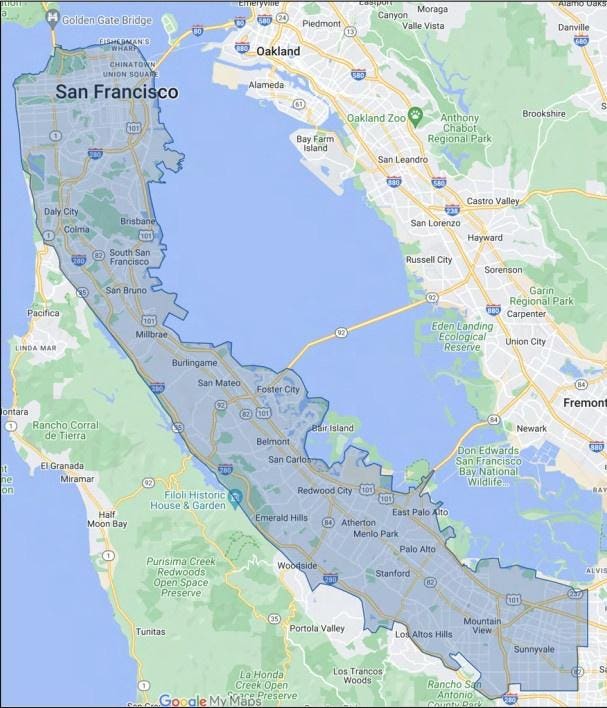Waymo’s requested service area near San Francisco covers most of the peninsula
Waymo/CPUC
Waymo, the robotaxi service of Alphabet/Google, has received approval from the California Public Utilities Commission for their request to expand their robotaxi service area to include the full San Francisco Peninsula (and much of Silicon Valley) and a large fraction of the Los Angeles area. This will allow them to experiment with services much closer in scope to the planned commercial operations that can turn their service into something profitable.
Previous reports on other media suggested that the PUC had suspended the application and would not act on it until June. These reports were false, and according to Waymo, resulted from a normal announcement of delay when an application won’t be processed in the normal 30 days. It took just a few days more. The reports were generated because the county of San Mateo, which contains a large part of the San Francisco Peninsula expansion, had expressed some opposition to it. San Mateo County Attorney John Nibbelin reportedly complained to the CPUC that Waymo had failed to communicate properly with them, but quickly retracted the claim and admitted Waymo had met with several members of the Board of Supervisors and the County Executive. Waymo also indicated it had held many briefings with county stakeholders.
San Mateo’s position, and its false claim, reflect the hostility that has been present in a few other municipalities, in particular the City of San Francisco. In California, all driving on the roads is regulated by the state DMV, and taxi services are regulated by the CPUC. Cities do not have authority over the roads, though they do control curbs and parking This has frustrated some of the cities, though some other locations, such as the Phoenix area and Austin, have had more harmonious relations with the robotaxi companies.
Robotaxi companies say they are making strong efforts to have good relations with the cities in which they drive, though they appear to be reluctant to go too far, concerned about the difficulty of being regulated by the eventual thousands of governments where their vehicles plan to drive. Even the Peninsula expansion sites them in 21 cities and 3 counties, and expansion to the whole Bay Area would more than double that. This difficulty is the reason regulatory authority has been left to the states, but that hasn’t made the cities happy. They have lobbied in Sacramento, and there are some proposed bills there which would grant more authorities to the municipalities, but their prospects for passing are not yet clear.
Serving the peninsula and LA is an easier driving task than downtown San Francisco, more akin to what they have done in Phoenix. Indeed, Waymo was born and did most of its initial driving on the peninsula, so it’s very familiar territory for them. On the other hand, rides there of any distance will need freeways to be competitive, and at present Waymo doesn’t carry the public at freeway speeds, though they have been testing with employees. Freeway driving is much simpler, but also riskier, due to the severity of any crash. Both LA and the SF peninsula are very “car dependent” areas which make a special challenge for any taxi-style service. Waymo is still probably barred from SFO airport, which is governed by the city of San Francisco, which has made itself an enemy of Waymo. SJC airport is just outside its new service area. LAX airport is covered, if they can get permission to go there. Waymo has also met resistance in LA for its expansion,
Waymo’s application for a Los Angeles service area
Waymo/CPUC
These large service areas are a major step. Waymo also covers a large section of the Phoenix metro area. Once in operation, running in three large cities will make Waymo a significant concern, and will respond to the criticism (which mostly comes from Tesla advocates who incorrectly think it is extremely difficult for robotaxis that have defined service areas and make extensive use of maps to expand to usable service areas.
These new areas are not like the dense urban streets of San Francisco. SF has many cars, but it also has many residents who don’t own cars. It was the birthplace of the ridehail business through Sidecar, which was quickly copied by UberX and Lyft which were also born there. The Peninsula and LA, like Phoenix, are lower density, and they are cities with high car ownership and dependency. They don’t have highly usable transit in most of their zones. It’s less challenging to drive there, but harder to get people out of their cars and into robotaxis.
It’s also unfortunate that the service areas are not quite large enough to offer a full “car replacement” service to many people. SF residents frequently travel to the East Bay and Marin. Silicon Valley residents frequently go to San Jose, Cupertino and Santa Clara. As such it would be harder for them to decide to replace their car with Waymo, since it can’t take them many places they want to go.
That said, the areas are still very large and will allow Waymo to learn a lot and get closer to having a true production service, and eventually one that makes a gross margin, showing a path to profits. Waymo just reached 15 years old, and most companies don’t get that old without their profit path well defined—this is the advantage of having a wealthy patron like Google, and its visionary founders.
While Waymo can’t cater to the desires of every city in which their vehicles will eventually drive, and the California legislature would be foolish to force that, they have learned from San Francisco that they have to do a better job with the very first locations they drive in. Hopefully they will soon get better relations with San Mateo and Los Angeles. Waymo and Google are headquartered in Santa Clara County, and will presumably have better relations there.
In addition, since I began with Waymo when they were a year old, I am pleased to see they should soon offer service at my home.




